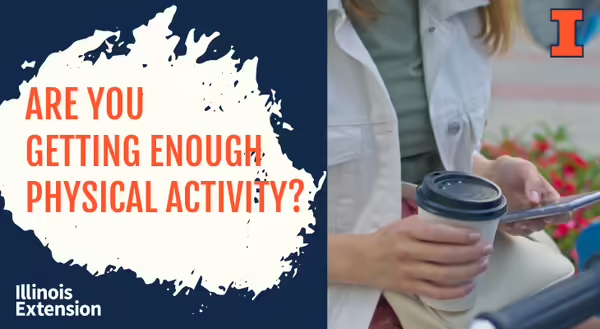
Are you getting enough physical activity?
Sadly, if you are like most adults and teens, you are not getting the recommended amount of physical activity. In fact, only one in four adults and one in five teens meet the recommended 150-300 minutes/week of moderate-intensity or 75-150 minutes/week of vigorous physical. However, with spring and warmer weather right around the corner, now is the perfect time to increase your physical activity.
Physical activity and exercise are two different terms with different definitions. However, they are often used interchangeably in part because exercise has many negative connotations and is often viewed as unenjoyable. Whereas physical activity implies, one is merely engaging in an activity.
I must admit I am guilty of misusing these terms when talking about living a healthy lifestyle. I do this because I understand many do not view exercise in a positive light. And I want people to be excited about movement, whether they have been exercising for years or are simply being intentional about moving more today than they did yesterday.
Both physical activity and exercise play a significant role in helping individuals reach their wellness goals. To help clarify things to clear up any confusion, let’s break down the terms.
Physical Activity
Physical activity refers to any bodily movement produced by skeletal muscles requiring energy. This means any movement such as going for a walk, getting out of bed, doing yard work, or making breakfast.
Exercise
Exercise in a subset of physical activity. It is any planned, structured, and repetitive body movement intended to improve physical fitness and health. Going for a walk is a form of exercise, especially when walking at a brisk pace or riding a bicycle.
Exercise can be further broken down into subcategories, which include aerobic, muscle-strengthening, endurance, and flexibility activities. It is important to note that any regular exercise routine should consist of a combination of these activities, as each offers different health benefits.
What can you do to become more active?
Set personal goals. Goals help to motivate you and provide direction and focus. They also provide accountability and allow you to track your progress. Research shows individuals who track their goals are more likely to reach them. Thus, you have nothing to strive for if you never set a goal.
Choose activities you enjoy. A key component to a successful exercise regimen is to include various activities you enjoy. Selecting a variety of activities will prevent boredom and reduce the risk of injury to joints and muscles due to overuse. Incorporating aerobic, muscle-strengthening, and flexibility exercises into your routine will provide you with many positive health benefits.
Make it a habit. Get the most out of your exercise routine by making it a habit. Habits are learned behaviors, often triggered by a specific situation or setting. Generally, habits begin as intentional behaviors such as brushing your teeth before bed, taking your shoes off as you enter the house, or walking during your lunch break. However, these behaviors become automatic or reflexive over time, waiting for the right trigger or situation to prompt the behavior. Therefore, being intentional about making exercise and physical activity a regular part of your day will help you make it a lifelong habit.
Workout with a friend. Motivation may wax and wane if you are like many when it comes to getting the recommended amount of physical activity. To help you stay motivated, find a friend or family member who enjoys the same types of physical activities and workout together.
Be safe. Incorporate various activities that will allow you to work all major muscle groups. This will provide a balanced workout and prevent injury. Wear supportive shoes that provide stability and adequate protection during activities. If you haven’t excised for a while, begin slowly, gradually increasing the duration and intensity of your workout. And above all, listen to your body and do not overdo it. Stop and take a break if you feel pain, shortness of breath, dizziness, or nausea. You may be pushing yourself too hard.
Everyone can benefit from physical activity and exercise no matter their age. After all, physical activity is a cornerstone for wellness and plays a significant role in improving brain health, strengthening bones and muscles, and reducing the risk of many chronic health conditions. So whether you are looking to prevent or manage a chronic illness or want to improve your ability to do everyday activities, I encourage you to simply Move More!
ABOUT THE AUTHOR: Diane Reinhold, MPH, MS, RDN, is a Nutrition and Wellness Educator with University of Illinois Extension, serving Jo Daviess, Stephenson, and Winnebago Counties. Diane is a registered dietitian nutritionist providing evidence-based programming focused on chronic disease prevention and management and food safety.
References
Braff, S. (2020, July 16). Physical Fitness and Physical Activity. Physical Fitness and Physical Activity. Retrieved February 21, 2022, from https://obesitymedicine.org/physical-fitness-and-physical-activity/
Centers for Disease Control and Prevention. (2017, February 17). NHIS - Adult physical activity - glossary. Centers for Disease Control and Prevention. Retrieved February 21, 2022, from https://bit.ly/3Nv9LTR
Centers for Disease Control and Prevention. (2019, September 25). Lack of physical activity. Centers for Disease Control and Prevention. Retrieved February 23, 2022, from https://bit.ly/36GDbh7
Habit. GoodTherapy.org Therapy Blog. (n.d.). Retrieved February 23, 2022, from https://www.goodtherapy.org/blog/psychpedia/habit
Soots, L., (2015, August 31). What are habits? The Positive Psychology People. Retrieved February 23, 2022, from https://www.thepositivepsychologypeople.com/habits-to-happiness/